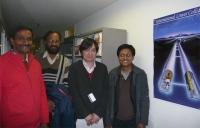 |
 |
|||||||||||||
|
|||||||||||||
|
|||||||||||||
|
India's Raja Ramanna Centre for Advanced Technology (RRCAT) is a leading institute for research and development in lasers, accelerators and their applications. In the Indian government's current five-year plan (April 2007-April 2012), building infrastructure and developing the technology of niobium superconducting radiofrequency (SCRF) cavities are the two major objectives for high-energy physics and accelerator-related projects. Following this plan, RRCAT wants to build its own electropolishing (EP) facility in India, and three scientists visited Japan to participate in the commissioning of the new EP system at KEK. Japan and India have a long history of collaboration, but it was based on rather personal relationships between scientists. This was the very first stay in Japan for three scientists under an official agreement between India and Japan. The three Indian scientists are working in different fields: P. Ram Sankar is interested in chemical surface modifications and treatments, the K.J.S Sokhey works in magnetic and superconducting materials section, and A. Bose works on material characterisation and joining techniques. They all visited with their own perspective to participate in the commissioning of the new EP system at KEK. Three rounds of electropolishing were carried out on test cavities during their stay at KEK. “Lots of input about SCRF facilities in USA and Europe were also provided during our weekly meetings, which I believe was important to know the overall status of the ILC project,” said Sokhey. “I was impressed by the manner the system was installed. Every small detail was taken care of nicely,” said Bose. In addition to the EP facility, they had the opportunity to learn about the fabrication of cavities. Kenji Ueno, Head of KEK's Mechanical Engineering Centre, who leads the designing and building of new EP facility, said, “I think it was a very good opportunity for these scientist who have great deal of knowledge to gain hands-on experience.” Ueno, who has a long experience in industry as an engineer, found their views very 'fresh' as those of 'pure' scientists. “Scientists in Japan work very closely with engineers, so most of them have some sort of engineer's approach towards scientific problems as well. Working with our Indian colleagues was a very nice opportunity for me, too,” he said. The primary purpose of their visit was to participate in the commissioning of the EP facility, but in addition to that, they gathered information on other related technologies as well, such as clean room facility, assembling of cavities inside the cryomodule, cavity forming technology and the vertical test facility. Hitoshi Hayano, Associate Professor of KEK's accelerator division, said, “I think their visit was very useful for them. They learned so much here. It is important to improve the Asian capability.” Back in India, they will soon start designing India's own EP machine. Another major objective of India's five-year plan is to join the R&D effort for international projects like the International Linear Collider and XFEL. RRCAT's request to join the TESLA Technology Collaboration (TTC) was approved in April last year. “We hope a significant contribution will be made in this direction by RRCAT,” Sankar said. -- Rika Takahashi |
|||||||||||||
| © International Linear Collider |
